Janus Biopolymer Sponge with Porous Structure Based on Water Hyacinth Petiole for Efficient Solar Steam Generation
Abstract
:1. Introduction
2. Results and Discussion
2.1. Fabrication and Morphology of Janus Sponge
2.2. Chemical Structure and Mechanical Property
2.3. Photothermal Property and Solar Steam Generation
3. Materials and Methods
3.1. Materials
3.2. Preparation of Janus Solar Evaporator
3.3. Characterization
3.4. Solar Evaporation Generation Experiment
4. Conclusions
Supplementary Materials
Author Contributions
Funding
Institutional Review Board Statement
Informed Consent Statement
Data Availability Statement
Conflicts of Interest
References
- Wang, J.; Liu, X. Forward osmosis technology for water treatment: Recent advances and future perspectives. J. Clean. Prod. 2021, 280, 124354. [Google Scholar] [CrossRef]
- Greenlee, L.F.; Lawler, D.F.; Freeman, B.D.; Marrot, B.; Moulin, P. Reverse osmosis desalination: Water sources, technology, and today’s challenges. Water Res. 2009, 43, 2317–2348. [Google Scholar] [CrossRef] [PubMed]
- Camacho, L.M.; Dumée, L.; Zhang, J.; Li, J.-d.; Duke, M.; Gomez, J.; Gray, S. Advances in membrane distillation for water desalination and purification applications. Water 2013, 5, 94–196. [Google Scholar] [CrossRef]
- Shon, H.K.; Phuntsho, S.; Chaudhary, D.S.; Vigneswaran, S.; Cho, J. Nanofiltration for water and wastewater treatment—A mini review. Drink. Water Eng. Sci. 2013, 6, 47–53. [Google Scholar] [CrossRef]
- El-Sebaii, A.A.; El-Bialy, E. Advanced designs of solar desalination systems: A review. Renew. Sustain. Energy Rev. 2015, 49, 1198–1212. [Google Scholar] [CrossRef]
- Zhang, L.; Xu, Z.; Zhao, L.; Bhatia, B.; Zhong, Y.; Gong, S.; Wang, E.N. Passive, high-efficiency thermally-localized solar desalination. Energy Environ. Sci. 2021, 14, 1771–1793. [Google Scholar] [CrossRef]
- Qiblawey, H.M.; Banat, F. Solar thermal desalination technologies. Desalination 2008, 220, 633–644. [Google Scholar] [CrossRef]
- Zhu, L.; Gao, M.; Peh, C.K.N.; Ho, G.W. Recent progress in solar-driven interfacial water evaporation: Advanced designs and applications. Nano Energy 2019, 57, 507–518. [Google Scholar] [CrossRef]
- Tao, P.; Ni, G.; Song, C.; Shang, W.; Wu, J.; Zhu, J.; Chen, G.; Deng, T. Solar-driven interfacial evaporation. Nat. Energy 2018, 3, 1031–1041. [Google Scholar] [CrossRef]
- Ghasemi, H.; Ni, G.; Marconnet, A.M.; Loomis, J.; Yerci, S.; Miljkovic, N.; Chen, G. Solar steam generation by heat localization. Nat. Commun. 2014, 5, 4449. [Google Scholar] [CrossRef]
- Wang, Z.; Horseman, T.; Straub, A.P.; Yip, N.Y.; Li, D.; Elimelech, M.; Lin, S. Pathways and challenges for efficient solar-thermal desalination. Sci. Adv. 2019, 5, eaax0763. [Google Scholar] [CrossRef] [PubMed]
- Zeng, F.; Zhan, Y.; Yuan, B.; Chu, L.; Li, W.; Siddiqui, A.R. Preparation of Janus melamine sponge suitable for solar evaporation. J. Mater. Sci. 2022, 57, 3601–3612. [Google Scholar] [CrossRef]
- Yang, Y.; Yang, X.; Fu, L.; Zou, M.; Cao, A.; Du, Y.; Yuan, Q.; Yan, C.-H. Two-dimensional flexible bilayer janus membrane for advanced photothermal water desalination. ACS Energy Lett. 2018, 3, 1165–1171. [Google Scholar] [CrossRef]
- Xu, W.; Hu, X.; Zhuang, S.; Wang, Y.; Li, X.; Zhou, L.; Zhu, S.; Zhu, J. Flexible and salt resistant Janus absorbers by electrospinning for stable and efficient solar desalination. Adv. Energy Mater. 2018, 8, 1702884. [Google Scholar] [CrossRef]
- Chen, X.; He, S.; Falinski, M.M.; Wang, Y.; Li, T.; Zheng, S.; Sun, D.; Dai, J.; Bian, Y.; Zhu, X. Sustainable off-grid desalination of hypersaline waters using Janus wood evaporators. Energy Environ. Sci. 2021, 14, 5347–5357. [Google Scholar] [CrossRef]
- Sheng, C.; Yang, N.; Yan, Y.; Shen, X.; Jin, C.; Wang, Z.; Sun, Q. Bamboo decorated with plasmonic nanoparticles for efficient solar steam generation. Appl. Therm. Eng. 2020, 167, 114712. [Google Scholar] [CrossRef]
- Chen, T.; Xie, H.; Qiao, X.; Hao, S.; Wu, Z.; Sun, D.; Liu, Z.; Cao, F.; Wu, B.; Fang, X. Highly anisotropic corncob as an efficient solar steam-generation device with heat localization and rapid water transportation. ACS Appl. Mater. Interfaces 2020, 12, 50397–50405. [Google Scholar] [CrossRef]
- Fang, J.; Liu, J.; Gu, J.; Liu, Q.; Zhang, W.; Su, H.; Zhang, D. Hierarchical porous carbonized lotus seedpods for highly efficient solar steam generation. Chem. Mater. 2018, 30, 6217–6221. [Google Scholar] [CrossRef]
- Liao, Y.; Chen, J.; Zhang, D.; Wang, X.; Yuan, B.; Deng, P.; Li, F.; Zhang, H. Lotus leaf as solar water evaporation devices. Mater. Lett. 2019, 240, 92–95. [Google Scholar] [CrossRef]
- Feng, J.; Bai, B.; Yang, L.; Hu, N.; Wang, H. Low-cost and facile hydrophilic amplification of raw corn straws for the applications of highly efficient interfacial solar steam generation. Mater. Chem. Phys. 2021, 271, 124904. [Google Scholar] [CrossRef]
- Fang, Q.; Li, T.; Chen, Z.; Lin, H.; Wang, P.; Liu, F. Full biomass-derived solar stills for robust and stable evaporation to collect clean water from various water-bearing media. ACS Appl. Mater. Interfaces 2019, 11, 10672–10679. [Google Scholar] [CrossRef] [PubMed]
- Storer, D.P.; Phelps, J.L.; Wu, X.; Owens, G.; Khan, N.I.; Xu, H. Graphene and rice-straw-fiber-based 3D photothermal aerogels for highly efficient solar evaporation. ACS Appl. Mater. Interfaces 2020, 12, 15279–15287. [Google Scholar] [CrossRef] [PubMed]
- Lu, Y.; Wang, X.; Fan, D.; Yang, H.; Xu, H.; Min, H.; Yang, X. Biomass derived Janus solar evaporator for synergic water evaporation and purification. Sustain. Mater. Technol. 2020, 25, e00180. [Google Scholar] [CrossRef]
- Liu, C.; Hong, K.; Sun, X.; Natan, A.; Luan, P.; Yang, Y.; Zhu, H. An ‘antifouling’porous loofah sponge with internal microchannels as solar absorbers and water pumpers for thermal desalination. J. Mater. Chem. A 2020, 8, 12323–12333. [Google Scholar] [CrossRef]
- Zhang, Q.; Ren, L.; Xiao, X.; Chen, Y.; Xia, L.; Zhao, G.; Yang, H.; Wang, X.; Xu, W. Vertically aligned Juncus effusus fibril composites for omnidirectional solar evaporation. Carbon 2020, 156, 225–233. [Google Scholar] [CrossRef]
- Xie, Z.; Zhu, J.; Zhang, L. Three-dimensionally structured polypyrrole-coated setaria viridis spike composites for efficient solar steam generation. ACS Appl. Mater. Interfaces 2021, 13, 9027–9035. [Google Scholar] [CrossRef]
- Liu, J.; Liu, Q.; Ma, D.; Yuan, Y.; Yao, J.; Zhang, W.; Su, H.; Su, Y.; Gu, J.; Zhang, D. Simultaneously achieving thermal insulation and rapid water transport in sugarcane stems for efficient solar steam generation. J. Mater. Chem. A 2019, 7, 9034–9039. [Google Scholar] [CrossRef]
- Xu, N.; Hu, X.; Xu, W.; Li, X.; Zhou, L.; Zhu, S.; Zhu, J. Mushrooms as efficient solar steam-generation devices. Adv. Mater. 2017, 29, 1606762. [Google Scholar] [CrossRef]
- Sun, P.; Zhang, W.; Zada, I.; Zhang, Y.; Gu, J.; Liu, Q.; Su, H.; Pantelic, D.; Jelenkovic, B.; Zhang, D. 3D-structured carbonized sunflower heads for improved energy efficiency in solar steam generation. ACS Appl. Mater. Interfaces 2019, 12, 2171–2179. [Google Scholar] [CrossRef]
- Wang, C.; Wang, J.; Li, Z.; Xu, K.; Lei, T.; Wang, W. Superhydrophilic porous carbon foam as a self-desalting monolithic solar steam generation device with high energy efficiency. J. Mater. Chem. A 2020, 8, 9528–9535. [Google Scholar] [CrossRef]
- Guna, V.; Ilangovan, M.; Anantha Prasad, M.G.; Reddy, N. Water hyacinth: A unique source for sustainable materials and products. ACS Sustain. Chem. Eng. 2017, 5, 4478–4490. [Google Scholar] [CrossRef]
- Malik, A. Environmental challenge vis a vis opportunity: The case of water hyacinth. Environ. Int. 2007, 33, 122–138. [Google Scholar] [CrossRef]
- Tanpichai, S.; Biswas, S.K.; Witayakran, S.; Yano, H. Water hyacinth: A sustainable lignin-poor cellulose source for the production of cellulose nanofibers. ACS Sustain. Chem. Eng. 2019, 7, 18884–18893. [Google Scholar] [CrossRef]
- Adesina, G.O.; Akanbi, W.B.; Olabode, O.S.; Akintoye, O. Effect of water hyacinth and neem based composts on growth, fruit yield and quality of cucumber (Cucumis sativus). Afr. J. Agric. Res. 2011, 6, 6477–6484. [Google Scholar] [CrossRef]
- Wang, J.; Chen, Y.; Xu, Y.; Mu, J.; Li, J.; Nie, S.; Chen, S.; Xu, F. Sustainable lignin-based electrospun nanofibers for enhanced triboelectric nanogenerators. Sustain. Energy Fuels 2022, 6, 1974–1982. [Google Scholar] [CrossRef]
- Hosen, M.D.; Hossain, M.S.; Islam, M.A.; Haque, A.N.M.A.; Naebe, M. Utilisation of natural wastes: Water-resistant semi-transparent paper for food packaging. J. Clean. Prod. 2022, 132665. [Google Scholar] [CrossRef]
- Chen, S.; Chen, Y.; Li, D.; Xu, Y.; Xu, F. Flexible and sensitivity-adjustable pressure sensors based on carbonized bacterial nanocellulose/wood-derived cellulose nanofibril composite aerogels. ACS Appl. Mater. Interfaces 2021, 13, 8754–8763. [Google Scholar] [CrossRef]
- Shandilya, M.; Thakur, S.; Thakur, S. Magnetic amendment in the fabrication of environment friendly and biodegradable iron oxide/ethyl cellulose nanocomposite membrane via electrospinning. Cellulose 2020, 27, 10007–10017. [Google Scholar] [CrossRef]
- Dowling, D.P.; Nwankire, C.E.; Riihimäki, M.; Keiski, R.; Nylén, U. Evaluation of the anti-fouling properties of nm thick atmospheric plasma deposited coatings. Surf. Coat. Technol. 2010, 205, 1544–1551. [Google Scholar] [CrossRef]
- Milella, A.; Palumbo, F.; Favia, P.; Cicala, G.; d’Agostino, R. Deposition mechanism of nanostructured thin films from tetrafluoroethylene glow discharges. Pure Appl. Chem. 2005, 77, 399–414. [Google Scholar] [CrossRef]
- Li, Y.; Wang, Y.; Wang, K.; Gomado, F.; Wang, G.; Tang, L.; Rong, X. The effect of N-ethyl-N-hydroxyethyl perfluorooctanoamide on wettability alteration of shale reservoir. Sci. Rep. 2018, 8, 1–9. [Google Scholar] [CrossRef] [PubMed]
- Bian, Y.; Tang, K.; Tian, L.; Zhao, L.; Zhu, S.; Lu, H.; Yang, Y.; Ye, J.; Gu, S. Sustainable solar evaporation while salt accumulation. ACS Appl. Mater. Interfaces 2021, 13, 4935–4942. [Google Scholar] [CrossRef] [PubMed]
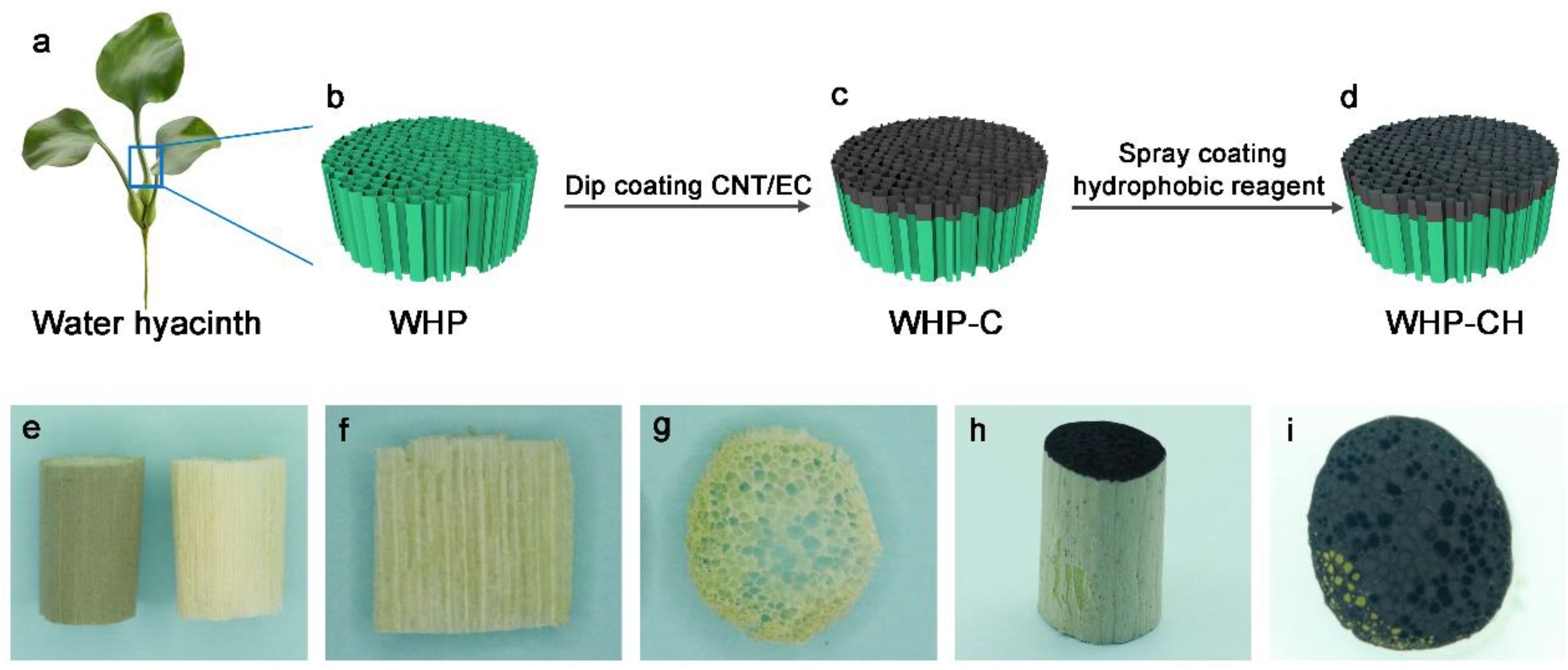
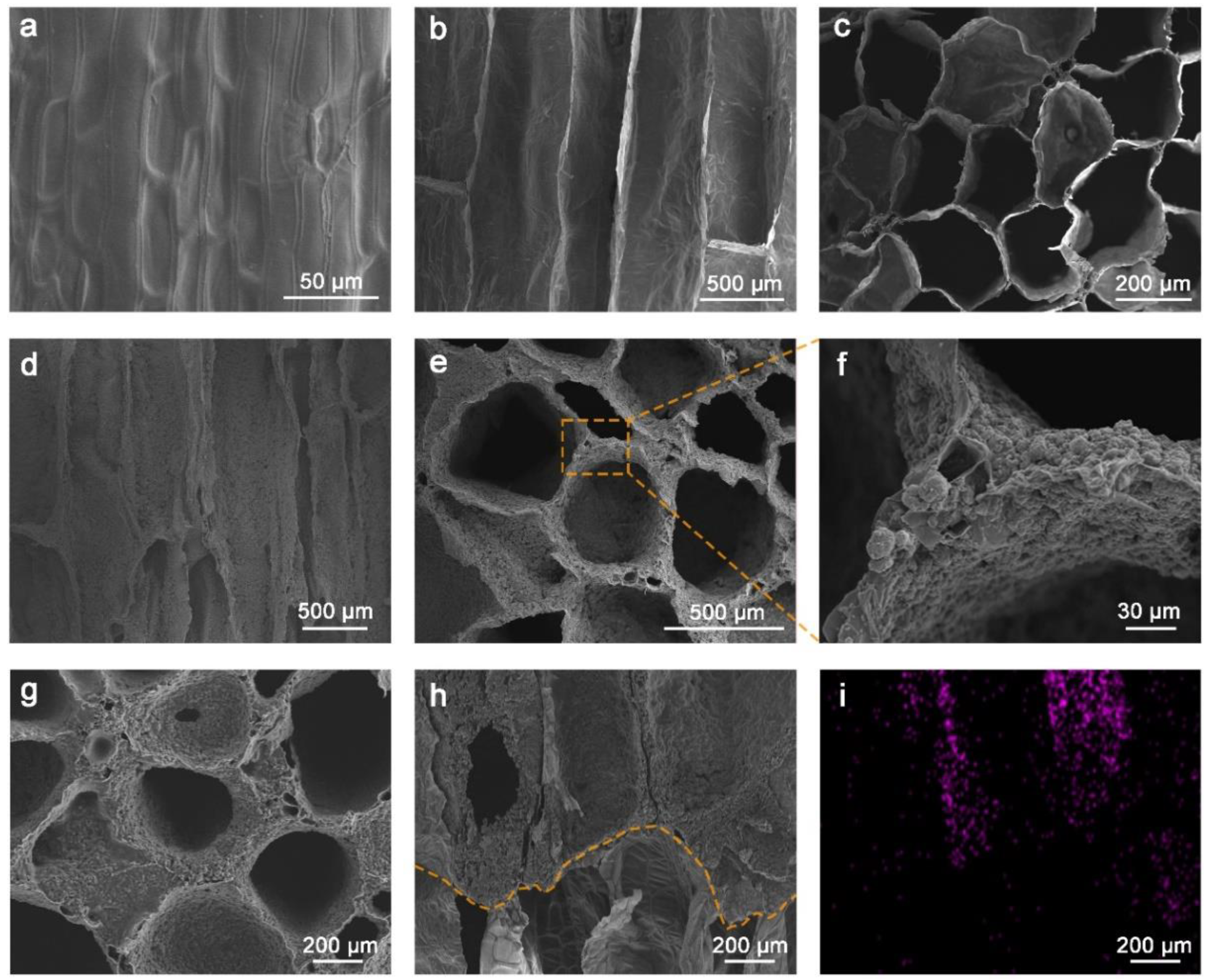
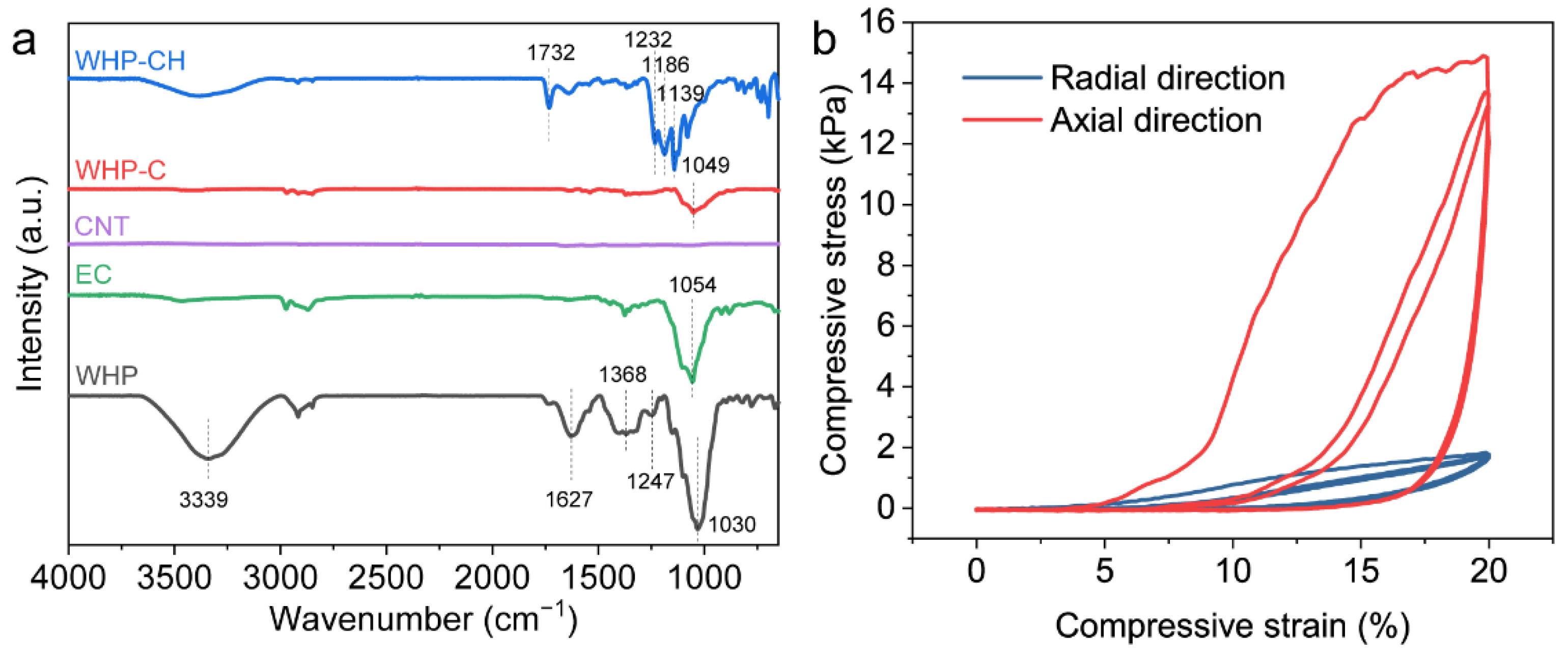
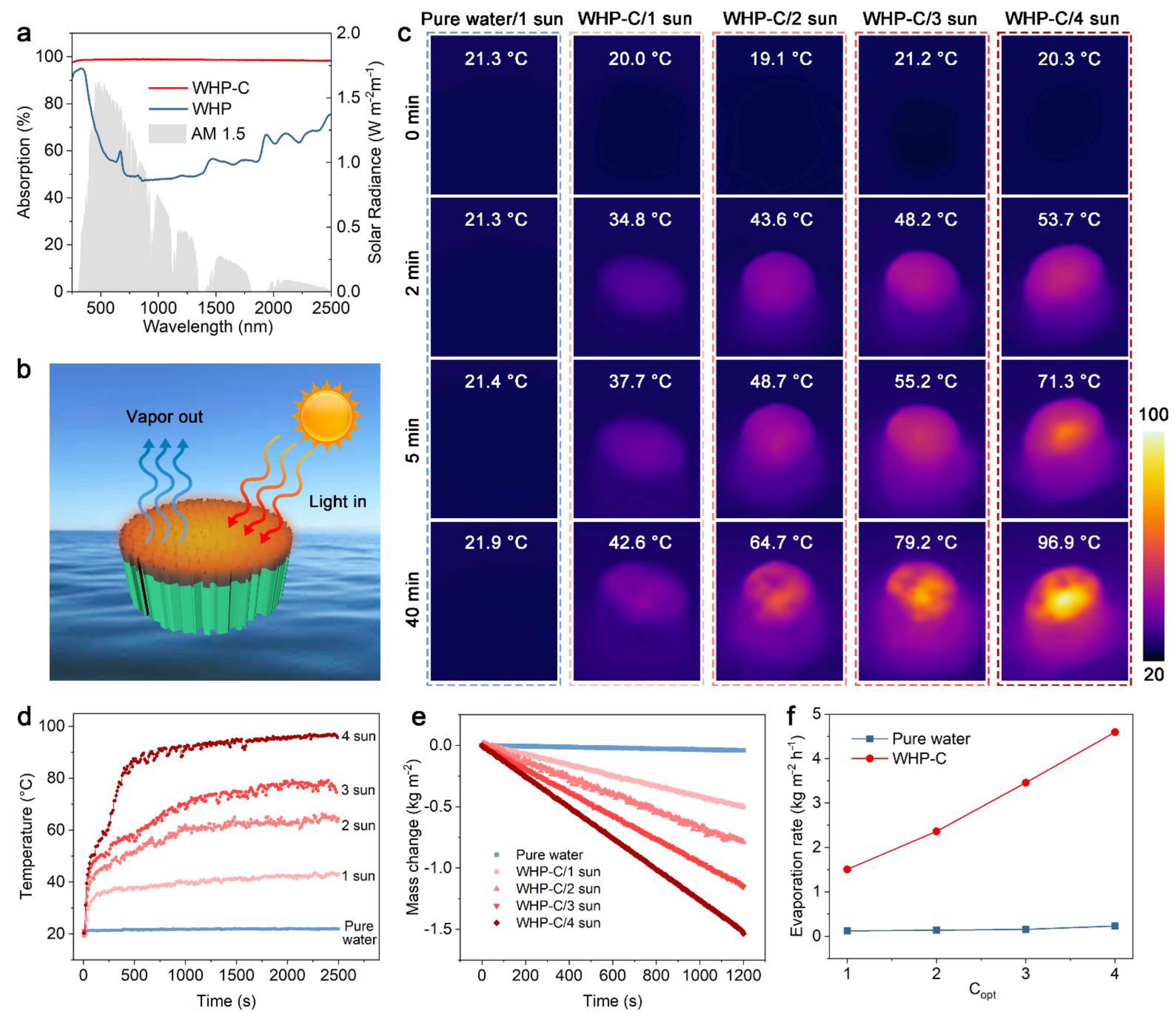
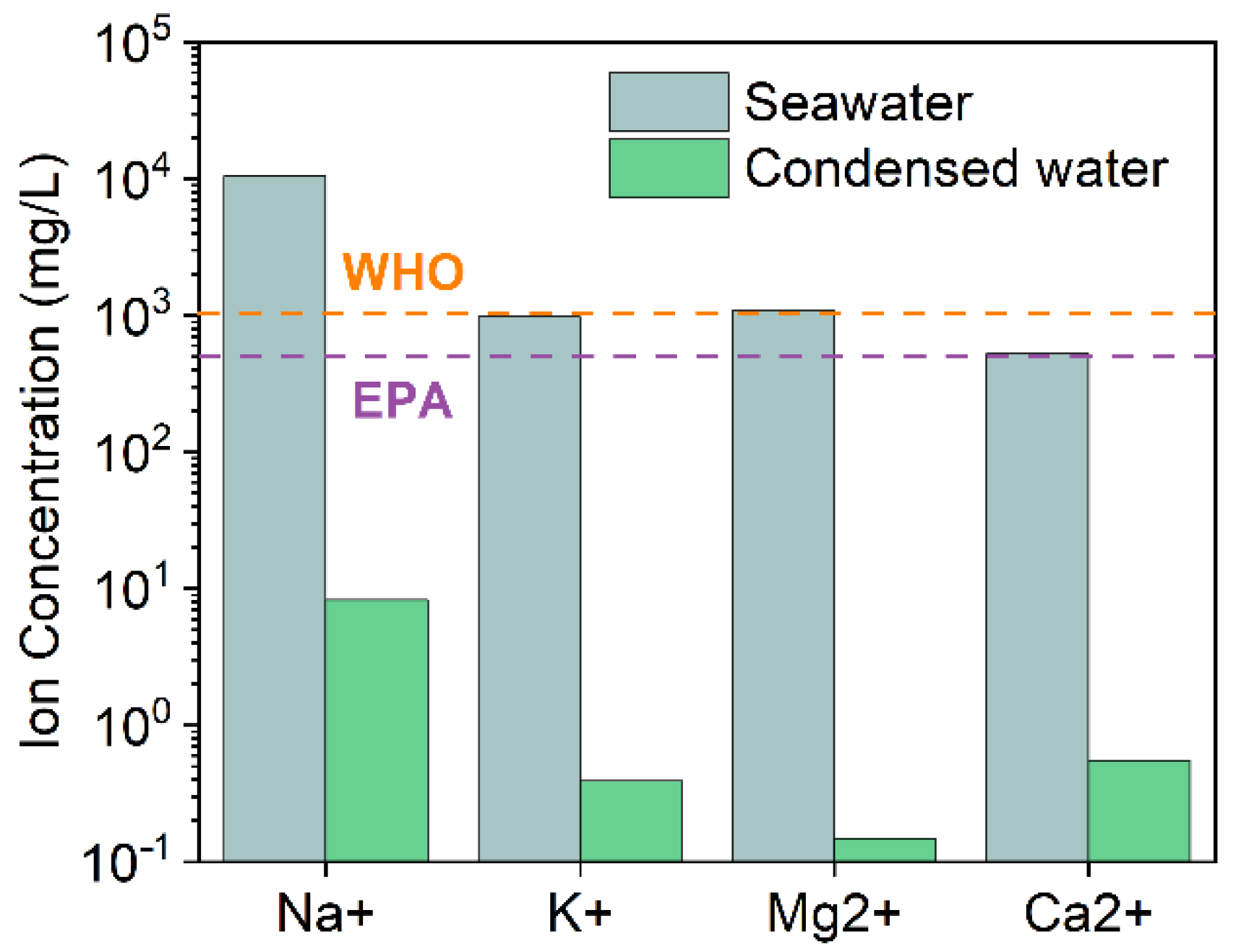
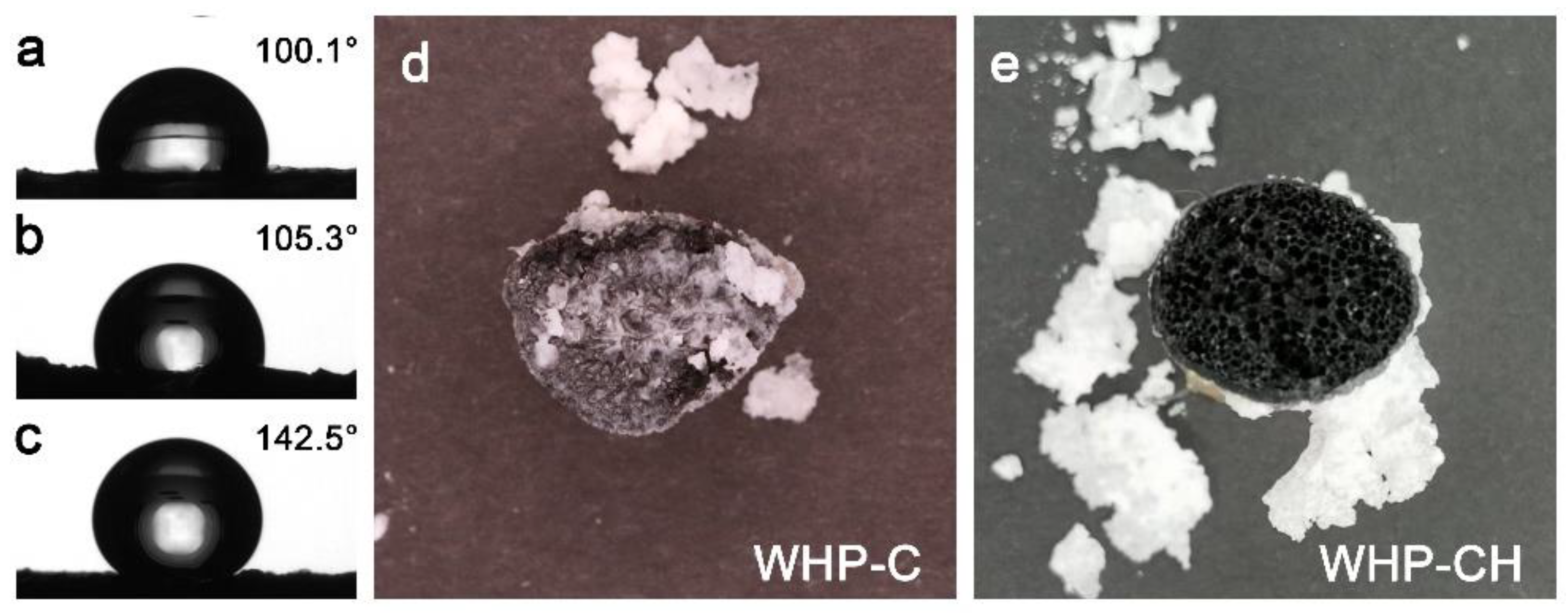
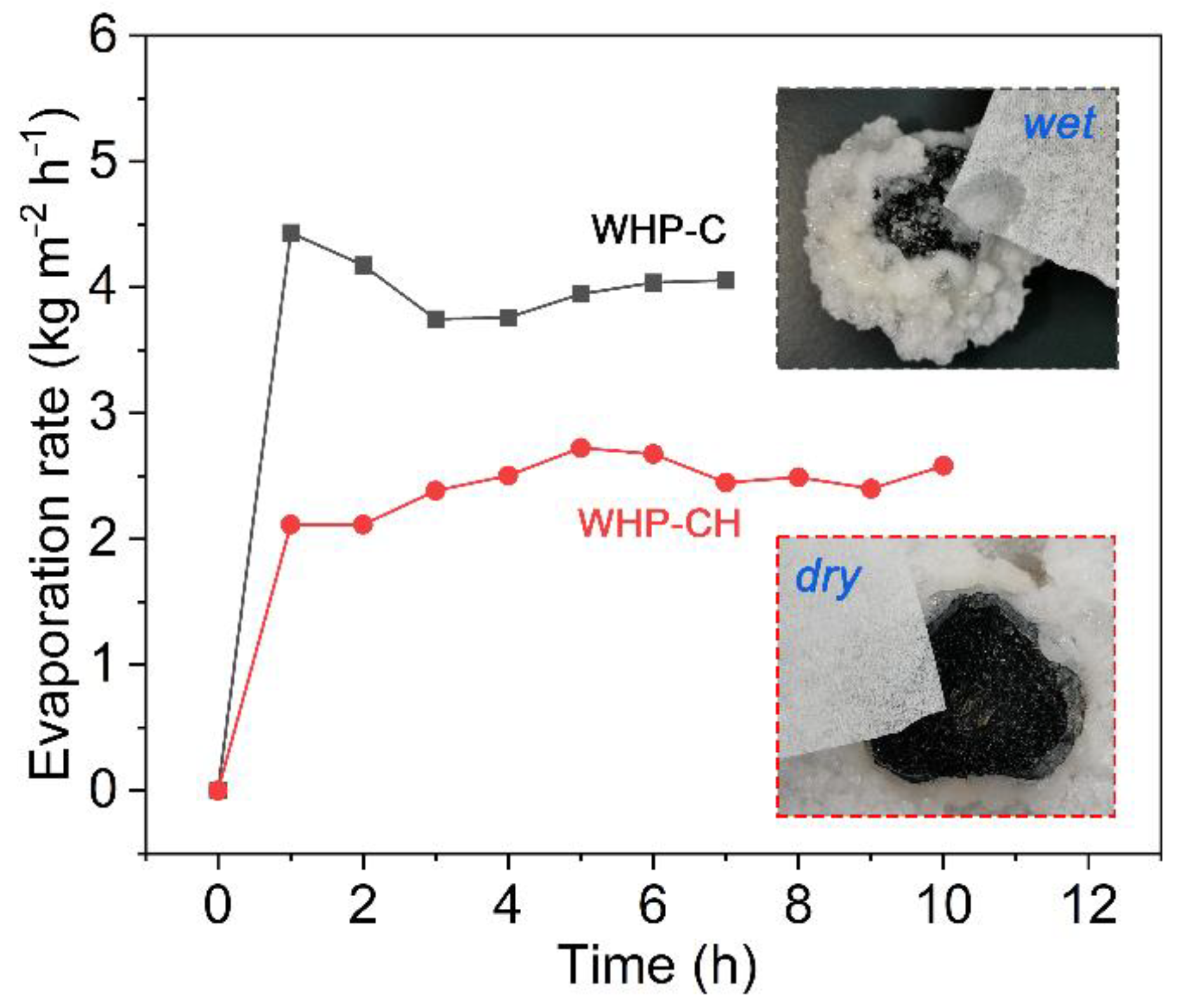
Publisher’s Note: MDPI stays neutral with regard to jurisdictional claims in published maps and institutional affiliations. |
© 2022 by the authors. Licensee MDPI, Basel, Switzerland. This article is an open access article distributed under the terms and conditions of the Creative Commons Attribution (CC BY) license (https://creativecommons.org/licenses/by/4.0/).
Share and Cite
Li, J.; Chen, S.; Li, C.; Cao, M.; Mu, J.; Nawaz, H.; Ling, Z.; Xu, F. Janus Biopolymer Sponge with Porous Structure Based on Water Hyacinth Petiole for Efficient Solar Steam Generation. Int. J. Mol. Sci. 2022, 23, 9185. https://doi.org/10.3390/ijms23169185
Li J, Chen S, Li C, Cao M, Mu J, Nawaz H, Ling Z, Xu F. Janus Biopolymer Sponge with Porous Structure Based on Water Hyacinth Petiole for Efficient Solar Steam Generation. International Journal of Molecular Sciences. 2022; 23(16):9185. https://doi.org/10.3390/ijms23169185
Chicago/Turabian StyleLi, Junying, Sheng Chen, Cuihuan Li, Mengyao Cao, Jiahui Mu, Haq Nawaz, Zhe Ling, and Feng Xu. 2022. "Janus Biopolymer Sponge with Porous Structure Based on Water Hyacinth Petiole for Efficient Solar Steam Generation" International Journal of Molecular Sciences 23, no. 16: 9185. https://doi.org/10.3390/ijms23169185
APA StyleLi, J., Chen, S., Li, C., Cao, M., Mu, J., Nawaz, H., Ling, Z., & Xu, F. (2022). Janus Biopolymer Sponge with Porous Structure Based on Water Hyacinth Petiole for Efficient Solar Steam Generation. International Journal of Molecular Sciences, 23(16), 9185. https://doi.org/10.3390/ijms23169185








